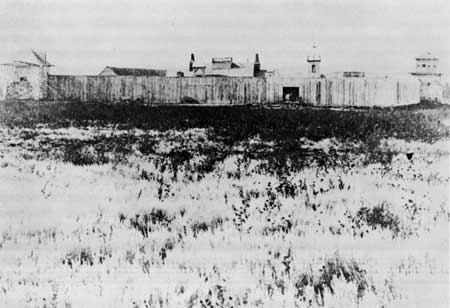|
The Upper Missouri Fur Trade Its Methods of Operation |
 |

Fort Union, 1866. Montana Historical Society
With the approach of white civilization on the Missouri in the middle of the 19th century, the once flourishing fur trade declined. Fort Pierre was sold to the Government in 1855. Although several other fur trading establishments sprang up in the vicinity, these had a short life.
Both the Civil War and the Sioux Uprising in Minnesota in the early 1860's, had an adverse effect on the Indian trade. The several military campaigns conducted by the army following the Sioux Uprising, had a disturbing influence on the trade relations of the two races. Suspected of pro-southern sympathies and their Indian trade sharply declining, the Chouteau's, in 1865, sold the Upper Missouri Outfit to the Northwestern Fur Company. [96]
During the late 1860's and the 1870's, much of the Indian trade was conducted by the sutler at the army posts or the authorized traders at the Indian agencies rather than at the old trading posts. Fort Union was abandoned in 1867. In 1869 the Northwest Fur Company sold out its business above Fort Buford and in the following year liquidated its business south of that post. For a few years the firm Durfee and Peck and several smaller outfits, continued to be active in the Indian business on the Upper Missouri.
During the 1870's and early 1880's, white hunters relentlessly pursued the remaining buffalo herds on the Northern Plains. The slaughter of these animals, upon which the Indian depended for food, made the red man subject to the white man's regulations. By 1884 the buffalo had been almost entirely destroyed. With the virtual annihilation of the bison herds, the fur trade ceased to be an important industry on the Upper Missouri.
The fur trading fraternity's contributions to the development of the Upper Missouri region, have been both positive and negative. Stories of the rich fur-bearing resources of the region no doubt resulted in encouraging many adventurous individuals to come into the region and explore every stream and ravine. In this way they made it easier for the permanent settlers.
The fur trader did very little toward furthering the civilization of the red man. Instead, he greatly exploited the Indian largely in the interests of a few absentee owners in St. Louis and New York. Although some instances may be cited where he materially helped the red man, these are far outweighed by those in which he plied the Indians with liquor, cheated him, and prostituted his women. He also introduced white man's diseases among the various tribes which killed thousands. As a result, the Indians became suspicious of all whites, a feeling which a century of consistent effort by the Government has been unable to eradicate.
The fur trader contributed little toward the permanent development of the region. He discouraged farming and permanent development since these would interfere with his business. Unlike his counterparts in Canada, as represented by the Hudson's Bay Company, the American trader destroyed the wild life very quickly and left the country in search of more fertile fields.

|

|
|
|
|
Last Modified: Sat, Jan 15 2005 10:00:00 am PDT |


